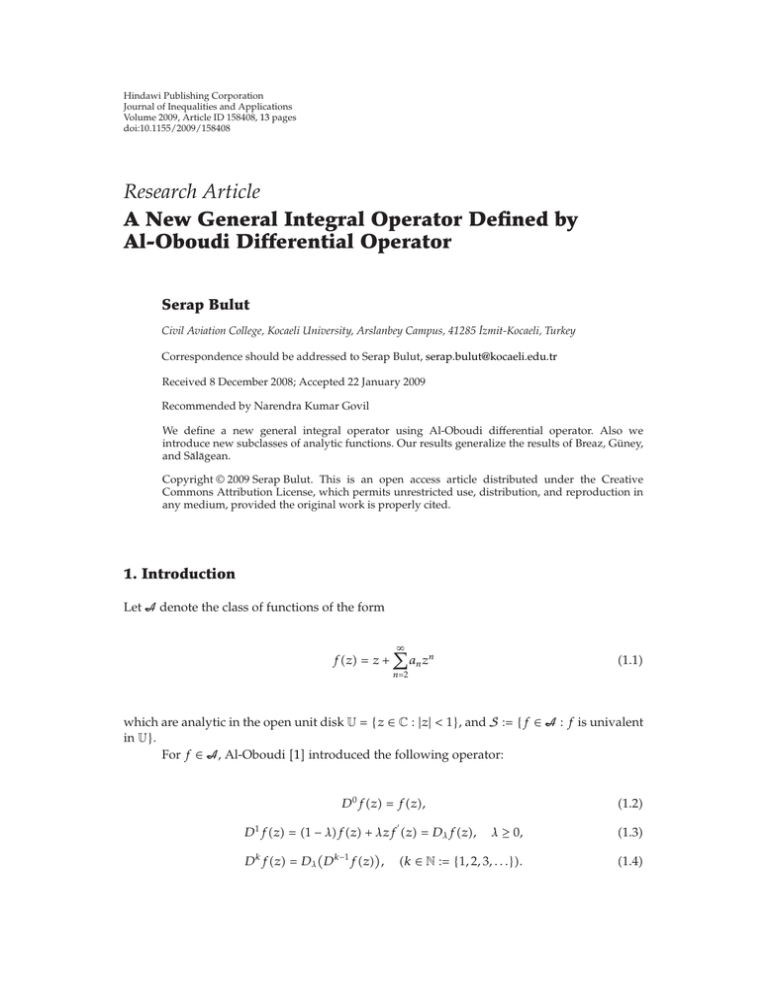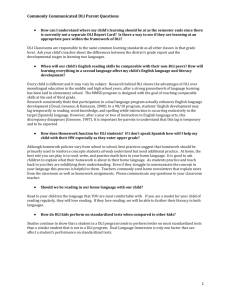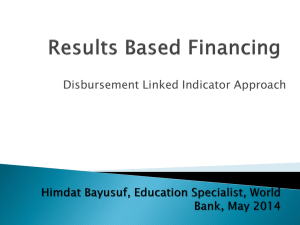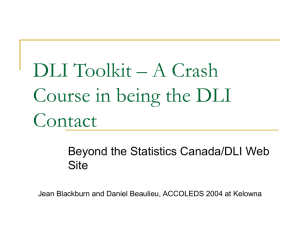Document 10980648
advertisement

Hindawi Publishing Corporation
Journal of Inequalities and Applications
Volume 2009, Article ID 158408, 13 pages
doi:10.1155/2009/158408
Research Article
A New General Integral Operator Defined by
Al-Oboudi Differential Operator
Serap Bulut
Civil Aviation College, Kocaeli University, Arslanbey Campus, 41285 İzmit-Kocaeli, Turkey
Correspondence should be addressed to Serap Bulut, serap.bulut@kocaeli.edu.tr
Received 8 December 2008; Accepted 22 January 2009
Recommended by Narendra Kumar Govil
We define a new general integral operator using Al-Oboudi differential operator. Also we
introduce new subclasses of analytic functions. Our results generalize the results of Breaz, Güney,
and Sălăgean.
Copyright q 2009 Serap Bulut. This is an open access article distributed under the Creative
Commons Attribution License, which permits unrestricted use, distribution, and reproduction in
any medium, provided the original work is properly cited.
1. Introduction
Let A denote the class of functions of the form
fz z ∞
an zn
1.1
n2
which are analytic in the open unit disk U {z ∈ C : |z| < 1}, and S : {f ∈ A : f is univalent
in U}.
For f ∈ A, Al-Oboudi 1 introduced the following operator:
D0 fz fz,
D1 fz 1 − λfz λzf z Dλ fz,
Dk fz Dλ Dk−1 fz ,
1.2
λ ≥ 0,
1.3
k ∈ N : {1, 2, 3, . . .}.
1.4
2
Journal of Inequalities and Applications
If f is given by 1.1, then from 1.3 and 1.4 we see that
Dk fz z ∞
1 n − 1λk an zn ,
k ∈ N0 : N ∪ {0} ,
1.5
n2
with Dk f0 0.
Remark 1.1. When λ 1, we get Sălăgean’s differential operator 2.
Now we introduce new classes Sk δ, b, λ and Kk δ, b, λ as follows.
A function f ∈ A is in the classes Sk δ, b, λ, where δ ∈ 0, 1, b ∈ C − {0}, λ ≥ 0, k ∈ N0 ,
if and only if
1
Re 1 b
Dk1 fz
−1
>δ
Dk fz
1.6
zDk fz
−1
>δ
Dk fz
1.7
or equivalently
λ
Re 1 b
for all z ∈ U.
A function f ∈ A is in the classs Kk δ, b, λ, where δ ∈ 0, 1, b ∈ C − {0}, λ ≥ 0, k ∈ N0 ,
if and only if
λ z Dk fz
>δ
Re 1 b Dk fz 1.8
for all z ∈ U.
We note that f ∈ Kk δ, b, λ if and only if zf ∈ Sk δ, b, λ.
Remark 1.2. i For k 0 and λ 1, we have the classes
S0 δ, b, 1 ≡ Sδ∗ b,
K0 δ, b, 1 ≡ Cδ b
1.9
introduced by Frasin 3.
ii For b 1 and λ 1, we have the class
Sk δ, 1, 1 ≡ Sk δ
1.10
of k-starlike functions of order δ defined by Sălăgean 2.
iii In particular, the classes
S0 δ, 1, 1 ≡ S∗ δ,
K0 δ, 1, 1 ≡ Kδ
1.11
Journal of Inequalities and Applications
3
are the classes of starlike functions of order δ and convex functions of order δ in U, respectively.
iv Furthermore, the classes
S0 0, 1, 1 ≡ S∗ ,
K0 0, 1, 1 ≡ K
1.12
are familiar classes of starlike and convex functions in U, respectively.
v For λ 1, we get
Kk δ, b, 1 ≡ Sk1 δ, b, 1.
1.13
Let us introduce the new subclasses USk α, δ, b, λ, UKk α, δ, b, λ and SHk α, b, λ,
KHk α, b, λ as follows.
A function f ∈ A is in the class USk α, δ, b, λ if and only if f satisfies
1
Re 1 b
1 Dk1 fz
Dk1 fz
−
1
−
1
>
α
δ
k
k
b
D fz
D fz
z ∈ U
1.14
or equivalently
λ
Re 1 b
k
z D fz
Dk fz
−1
λ z Dk fz
−
1
> α
δ,
k
b
D fz
1.15
where α ≥ 0, δ ∈ −1, 1, α δ ≥ 0, b ∈ C − {0}, λ ≥ 0, k ∈ N0 .
A function f ∈ A is in the class UKk α, δ, b, λ if and only if f satisfies
λ z Dk fz λ z Dk fz
Re 1 > α δ,
b Dk fz b Dk fz 1.16
where α ≥ 0, δ ∈ −1, 1, α δ ≥ 0, b ∈ C − {0}, λ ≥ 0, k ∈ N0 .
We note that f ∈ UKk α, δ, b, λ if and only if zf ∈ USk α, δ, b, λ.
Remark 1.3. i For α 0, we have
USk 0, δ, b, λ ≡ Sk δ, b, λ,
UKk 0, δ, b, λ ≡ Kk δ, b, λ.
1.17
ii For b 1 and λ 1, we have the class
USk α, δ, 1, 1 ≡ USk α, δ.
1.18
of k-uniform starlike functions of order δ and type α, 4.
iii For λ 1, we have
UKk α, δ, b, 1 ≡ USk1 α, δ, b, 1.
1.19
4
Journal of Inequalities and Applications
iv For b 1 and λ 1, we have
UKk α, δ, 1, 1 ≡ USk1 α, δ.
1.20
Geometric Interpretation
f ∈ USk α, δ, b, λ and f ∈ UKk α, δ, b, λ if and only if 1 λ/bzDk fz /Dk fz − 1
and 1 λ/bzDk fz /Dk fz , respectively, take all the values in the conic domain
Rα,δ which is included in the right-half plane such that
Rα,δ u iv : u > α u − 12 v2 δ .
1.21
From elementary computations we see that ∂Rα,δ represents the conic sections
symmetric about the real axis. Thus Rα,δ is an elliptic domain for α > 1, a parabolic domain
for α 1, a hyperbolic domain for 0 < α < 1 and a right-half plane u > δ for α 0.
A function f ∈ A is in the class SHk α, b, λ if and only if f satisfies
√
√
1 Dk1 fz
1 Dk1 fz
− 1 − 2α 2 − 1 < Re
−1
2 1
1 b
b
Dk fz
Dk fz
√
2α 2 − 1 z ∈ U,
1.22
where α > 0, b ∈ C − {0}, λ ≥ 0, k ∈ N0 .
A function f ∈ A is in the class KHk α, b, λ if and only if f satisfies
√
√
λ z Dk fz
λ z Dk fz
2 1
1 − 2α 2 − 1 < Re
b Dk fz b Dk fz √
2α 2 − 1 z ∈ U,
1.23
where α > 0, b ∈ C − {0}, λ ≥ 0, k ∈ N0 .
We note that f ∈ KHk α, b, λ if and only if zf ∈ SHk α, b, λ.
Remark 1.4. i For b 1 and λ 1, we have the classes
SHk α, 1, 1 ≡ SHk α,
KHk α, 1, 1 ≡ SHk1 α, 1, 1 ≡ SHk1 α
1.24
defined in 5.
ii For λ 1, we have
KHk α, b, 1 ≡ SHk1 α, b, 1.
1.25
Journal of Inequalities and Applications
5
D. Breaz and N. Breaz 6 introduced and studied the integral operator
Fn z z
0
f1 t
t
μ 1
···
fn t
t
μ n
1.26
dt,
where fi ∈ A and μi > 0 for all i ∈ {1, . . . , n}.
By using the Al-Oboudi differential operator, we introduce the following integral
operator. So we generalize the integral operator Fn .
Definition 1.5. Let k ∈ N0 , l l1 , . . . , ln ∈ Nn0 , and μi > 0, 1 ≤ i ≤ n. One defines the integral
operator Ik,n,l,μ : An → A,
Ik,n,l,μ f1 , . . . , fn F,
μ 1
μ n
z l1
ln
D
f
t
f
t
D
1
n
···
dt,
Dk Fz t
t
0
1.27
where f1 , . . . , fn ∈ A and D is the Al-Oboudi differential operator.
Remark 1.6. In Definition 1.5, if we set
i λ 1, then we have 7, Definition 1.
ii λ 1, k 0 and l1 · · · ln 0, then we have the integral operator defined
by 1.26.
iii k 0, l1 · · · ln l ∈ N0 , then we have 8, Definition 1.1.
2. Main Results
The following lemma will be required in our investigation.
Lemma 2.1. For the integral operator Ik,n,l,μ f1 , . . . , fn F, defined by 1.27, one has
n
n
λz Dk Fz
Dli 1 fi z −
μi l
μi .
k
D i fi z
D Fz
i1
i1
2.1
Proof. By 1.27, we get
k
D Fz Dl1 f1 z
z
μ 1
···
Dln fn z
z
μ n
.
2.2
Also, using 1.3 and 1.4, we obtain
Dk1 Fz − 1 − λDk Fz
.
Dk Fz λz
2.3
6
Journal of Inequalities and Applications
On the other hand, from 2.2 and 2.3, we find
k
D Fz
n
μi
i1
Dli fi z
z
l
μi l
μ j
n
D j fj z
z D i fi z − Dli fi z ,
z
zDli fi z
j1
2.4
j /
i
Dk Fz
Dk2 Fz − 2 − λDk1 Fz 1 − λDk Fz
.
λ2 z2
2.5
Thus by 2.2 and 2.4, we can write
l
n
Dk Fz
z D i fi z − Dli fi z
μi
k
zDli fi z
D Fz
i1
n
Dli 1 fi z − Dli fi z
.
μi
λzDli fi z
i1
2.6
n
λz Dk Fz
Dli 1 fi z
−1 ,
μi
k
Dli fi z
D Fz
i1
2.7
Finally, we obtain
which is the desired result.
Theorem 2.2. Let αi ≥ 0, δi ∈ −1, 1, αi δi ≥ 0 1 ≤ i ≤ n, and b ∈ C − {0}, λ ≥ 0. Also suppose
that
n
μi
i1
1 − δi
≤ 1.
1 αi
2.8
If fi ∈ USli αi , δi , b, λ1 ≤ i ≤ n, then the integral operator Ik,n,l,μ F, defined by 1.27, is in the
class Kk γ, b, λ, where
γ 1−
n
i1
μi
1 − δi
.
1 αi
2.9
Proof. Since fi ∈ USli αi , δi , b, λ1 ≤ i ≤ n, by 1.14 we have
1
Re 1 b
Dli 1 fi z
αi δi
−1
>
l
i
αi 1
D fi z
2.10
Journal of Inequalities and Applications
7
for all z ∈ U. By 2.1, we get
n
1 Dli 1 fi z
1 λz Dk Fz
−1
1
μi
1
b Dk Fz b
Dli fi z
i1
n
n
1 Dli 1 fi z
1
−1
−
μi 1 μi .
l
b
D i fi z
i1
i1
2.11
So, 2.10 and 2.11 give us
n
n
1 λz Dk Fz
1 Dli 1 fi z
1−
Re 1 −1
μi μi Re 1 b Dk Fz b
Dli fi z
i1
i1
n
n
n
αi δi
1 − δi
1−
>1−
μi μi
μi
αi 1
1 αi
i1
i1
i1
for all z ∈ U. Hence, we obtain F ∈ Kk γ, b, λ, where γ 1 −
n
i1
2.12
μi 1 − δi /1 αi .
Corollary 2.3. Let αi ≥ 0, δi ∈ −1, 1, αi δi ≥ 01 ≤ i ≤ n, and b ∈ C − {0}. Also suppose that
n
μi
i1
1 − δi
≤ 1.
1 αi
2.13
If fi ∈ USli αi , δi , b, 1 1 ≤ i ≤ n, then the integral operator Ik,n,l,μ F, defined by 1.27, is in the
class Sk1 γ, b, 1, where γ is defined as in 2.9.
Proof. In Theorem 2.2, we consider λ 1.
From Corollary 2.3, we immediately get Corollary 2.4.
Corollary 2.4. Let αi ≥ 0, δi ∈ −1, 1, αi δi ≥ 0 1 ≤ i ≤ n, and b ∈ C − {0}. Also suppose that
n
i1
μi
1 − δi
≤ 1.
1 αi
2.14
If fi ∈ USli αi , δi , b, 1 1 ≤ i ≤ n, then the integral operator Ik,n,l,μ F, defined by 1.27, is in the
class Sk1 0, b, 1.
Remark 2.5. If we set b 1 in Corollary 2.4, then we have 7, Theorem 1. So Corollary 2.4 is
an extension of Theorem 1.
Corollary 2.6. Let δi ∈ 0, 11 ≤ i ≤ n and b ∈ C − {0}, λ ≥ 0. Also suppose that
n
i1
μi 1 − δi ≤ 1.
2.15
8
Journal of Inequalities and Applications
If fi ∈ Sli δi , b, λ1 ≤ i ≤ n, then the integral operator Ik,n,l,μ F, defined by 1.27, is in the class
Kk ρ, b, λ, where
ρ 1−
n
μi 1 − δi .
2.16
i1
Proof. In Theorem 2.2, we consider α1 α2 · · · αn 0.
Corollary 2.7. Let δi ∈ 0, 1 1 ≤ i ≤ n and b ∈ C − {0}. Also suppose that
n
μi 1 − δi ≤ 1.
2.17
i1
If fi ∈ Sli δi , b, 1 1 ≤ i ≤ n, then the integral operator Ik,n,l,μ F, defined by 1.27, is in the class
Sk1 ρ, b, 1, where ρ is defined as in 2.16.
Proof. In Corollary 2.6, we consider λ 1.
Corollary 2.8 readily follows from Corollary 2.7.
Corollary 2.8. Let δi ∈ 0, 1 1 ≤ i ≤ n, and b ∈ C − {0}. Also suppose that
n
μi 1 − δi ≤ 1.
2.18
i1
If fi ∈ Sli δi , b, 1 1 ≤ i ≤ n, then the integral operator Ik,n,l,μ F, defined by 1.27, is in the class
Sk1 0, b, 1.
Remark 2.9. If we set b 1 in Corollary 2.8, then we have 7, Corollary 1.
Theorem 2.10. Let αi ≥ 0, δi ∈ −1, 1, αi δi ≥ 0 1 ≤ i ≤ n and b ∈ C − {0}, λ ≥ 0. Also suppose
that
n
μi ≤ 1.
2.19
i1
If fi ∈ USli αi , δi , b, λ 1 ≤ i ≤ n, then the integral operator Ik,n,l,μ F , defined by 1.27, is in the
class Kk γ, b, λ, where γ is defined as in 2.9.
Proof. The proof is similar to the proof of Theorem 2.2.
Corollary 2.11. Let αi ≥ 0, δi ∈ −1, 1, αi δi ≥ 0 1 ≤ i ≤ n and b ∈ C − {0}. Also suppose that
n
i1
μi ≤ 1.
2.20
Journal of Inequalities and Applications
9
If fi ∈ USli αi , δi , b, 1 1 ≤ i ≤ n, then the integral operator Ik,n,l,μ F, defined by 1.27, is in the
class Sk1 γ, b, 1, where γ is defined as in 2.9.
Proof. In Theorem 2.10, we consider λ 1.
Remark 2.12. If we set b 1 in Corollary 2.11, then we have 7, Theorem 2.
Corollary 2.13. Let δi ∈ 0, 11 ≤ i ≤ n and b ∈ C − {0}, λ ≥ 0. Also suppose that
n
μi ≤ 1.
2.21
i1
If fi ∈ Sli δi , b, λ 1 ≤ i ≤ n, then the integral operator Ik,n,l,μ F, defined by 1.27, is in the class
Kk ρ, b, λ, where ρ is defined as in 2.16.
Proof. In Theorem 2.10, we consider α1 α2 · · · αn 0.
Corollary 2.14. Let δi ∈ 0, 11 ≤ i ≤ n and b ∈ C − {0}. Also suppose that
n
μi ≤ 1.
2.22
i1
If fi ∈ Sli δi , b, 1 1 ≤ i ≤ n, then the integral operator Ik,n,l,μ F, defined by 1.27, is in the class
Sk1 ρ, b, 1, where ρ is defined as in 2.16.
Proof. In Corollary 2.13, we consider λ 1.
Remark 2.15. If we set b 1 in Corollary 2.14, then we have 7, Corollary 2.
Theorem 2.16. Let α ≥ 0, δ ∈ −1, 1, α δ ≥ 0 and b ∈ C − {0}, λ ≥ 0. Also suppose that
n
μi ≤ 1.
2.23
i1
If fi ∈ USli α, δ, b, λ 1 ≤ i ≤ n, then the integral operator Ik,n,l,μ F, defined by 1.27, is in the
class UKk α, δ, b, λ.
Proof. Since fi ∈ USli α, δ, b, λ 1 ≤ i ≤ n, by 1.14 we have
1
Re 1 b
for all z ∈ U.
1 Dli 1 f z
Dli 1 fi z
i
−
1
>
α
−
1
δ
b
Dli fi z
Dli fi z
2.24
10
Journal of Inequalities and Applications
On the other hand, from 2.1, we obtain
n
λ z Dk Fz
1 Dli 1 fi z
1
−1
μi
1
b Dk Fz b
Dli fi z
i1
n
n
1 Dli 1 fi z
−1 .
μi μi 1 1−
b
Dli fi z
i1
i1
2.25
Considering 1.16 with the above equality, we find
λ z Dk Fz λ z Dk Fz
Re 1 − α −δ
b Dk Fz b Dk Fz n
n
n
1 Dli 1 fi z
1 Dli 1 fi z
1−
−
1
−
1
−
α
μi μi Re 1 μ
−δ
i
li f z
li f z
b
b
D
D
i
i
i1
i1
i1
n
n
n
1 Dli 1 f z
1 Dli 1 fi z
i
≥1−
−
1
−
α
−
1
μi μi Re 1 μ
−δ
i
l
l
i
i
b
b
D fi z
D fi z
i1
i1
i1
n
n
n
1 Dli 1 f z
1 Dli 1 f z
i
i
>1−
δ
−
α
−
1
−
1
μi μi α
μ
−δ
i
l
l
i
i
b
b
D fi z
D fi z
i1
i1
i1
n
1 − δ 1 −
μi ≥ 0
i1
2.26
for all z ∈ U. This completes proof.
Corollary 2.17. Let α ≥ 0, δ ∈ −1, 1, α δ ≥ 0, and b ∈ C − {0}. Also suppose that
n
μi ≤ 1.
2.27
i1
If fi ∈ USli α, δ, b, 1 1 ≤ i ≤ n, then the integral operator Ik,n,l,μ F, defined by 1.27, is in the
class USk1 α, δ, b, 1.
Proof. In Theorem 2.16, we consider λ 1.
Remark 2.18. If we set b 1 in Corollary 2.17, then we have 7, Theorem 3.
Theorem 2.19. Let α ≥ 0, b ∈ C − {0}, and λ ≥ 0. Also suppose that
n
μi ≤ 1.
2.28
i1
If fi ∈ SHli α, b, λ 1 ≤ i ≤ n, then the integral operator Ik,n,l,μ F, defined by 1.27, is in the
class KHk α, b, λ.
Journal of Inequalities and Applications
11
Proof. Since fi ∈ SHli α, b, λ 1 ≤ i ≤ n, by 1.22 we have
Re
√
√ l 1
√
√
1 Dli 1 fi z
2 D i fi z
−1
2α 2 − 1 − 1 − 1 − 2α 2 − 1 > 0
2
b
b
Dli fi z
Dli fi z
2.29
for all z ∈ U. Considering this inequality and 2.1, we obtain
√
√
√
√
1 λz Dk Fz
2 λz Dk Fz
Re
2α 2 − 1 − 1 2
− 2α 2 − 1 k
b
b Dk Fz D Fz
Re
√
√
n
2
2
μi
b i1
√
Dli 1 fi z
−
1
2α
2−1
Dli fi z
n
√
Dli 1 fi z
1
− 1 − 1 − 2α 2 − 1 μi
b i1
Dli fi z
√
√ √
2 Dli 1 fi z
−
1
2α
2
2−1
μi Re
l
i
b
D fi z
i1
n
n
√
1 Dli 1 fi z
− 1 − 1 − 2α 2 − 1 μi
b
Dli fi z
i1
√
2
n
μi Re
√
i1
√ l 1
n
√ √
2 D i fi z
−
1
−
2
2
μi 2α 2 − 1
l
i
b
D fi z
i1
n
n
n
√
√
√
1 Dli 1 fi z
− 1 μi 1
−1 −2α 2−1 − μi 2α 2−1
μi −2α 2−1 i1
b
Dli fi z
i1
i1
√
2 1−
n
μi
i1
√ l 1
n
√
√
2 D i fi z
2α 2 − 1 −1
μi Re
2
b
Dli fi z
i1
n
n
√
√
1 Dli 1 fi z
1−
− 1 − 2α 2 − 1 μi μi 1 − 1 − 2α 2 − 1
b
Dli fi z
i1
i1
≥
√
2 1−
n
μi
i1
√ l 1
n
√
√
2 D i fi z
2α 2 − 1 −1
μi Re
2
b
Dli fi z
i1
n
n
li 1
√
√
f
z
D
1
i
− 1 − 2α 2 − 1 μi −
μi 1 − 1 − 2α 2 − 1 1 −
b
Dli fi z
i1
i1
n
n
√
√
2α 2 − 1
μi − 2α 2 − 1
μi
i1
i1
12
n
√
√
√
1−
2 2α 2 − 1 − 1 − 2α 2 − 1
μi
Journal of Inequalities and Applications
i1
√ l 1
√
√
√
1 Dli 1 fi z
2 D i fi z
μi Re
−1
2α 2−1 − 1
−1 −2α 2−1 2
b
b
Dli fi z
Dli fi z
i1
n
n
√
√
√
>
2 2α 2 − 1 − 1 − 2α 2 − 1 1 −
μi
i1
>
1−
n
μi
min
√
√
2 − 1 1 4α, 2 1 ≥ 0
i1
2.30
for all z ∈ U. Hence by 1.23, we have F ∈ KHk α, b, λ.
Corollary 2.20. Let α ≥ 0 and b ∈ C − {0}. Also suppose that
n
μi ≤ 1.
2.31
i1
If fi ∈ SHli α, b, 1 1 ≤ i ≤ n, then the integral operator Ik,n,l,μ F, defined by 1.27, is in the
class SHk1 α, b, 1.
Proof. In Theorem 2.19, we consider λ 1.
Remark 2.21. If we set b 1 in Corollary 2.20, then we have 7, Theorem 4.
Theorem 2.22. Let α ≥ 0, b ∈ C − {0} and λ ≥ 0. Also suppose that
1
√
n
√
2α 2 − 1
μi < 1.
2.32
i1
If fi ∈ SHli α, b, λ 1 ≤ i ≤ n, then the integral operator Ik,n,l,μ F, defined by 1.27, is in the
class Kk 0, b, λ.
Proof. Since fi ∈ SHli α, b, λ 1 ≤ i ≤ n, by 1.22 we have
Re
√
√ l 1
√
√
1 Dli 1 fi z
2 D i fi z
−1
2α 2 − 1 > 1 − 1 − 2α 2 − 1 2
b
b
Dli fi z
Dli fi z
2.33
Journal of Inequalities and Applications
13
for all z ∈ U. Considering this inequality and 2.1, we obtain
√
λ z Dk fz
2Re 1 b Dk fz Re
√
√ n l 1
D i fi z
2
−1
2
μi
b i1
Dli fi z
√ l 1
n
n
√ √
√
2 D i fi z
−1
μi Re
2
2 − 2 μi b
Dli fi z
i1
i1
√ l 1
n
n
n
√
√ √ √
√
2 D i fi z
−1
2α 2−1
μi μi Re
2
2− 2 μi −2α 2−1
b
Dli fi z
i1
i1
i1
n
√
√ √
> 2 1 − 1 2α 2 − 1
μi > 0
i1
2.34
for all z ∈ U. Hence, by 1.8, we have F ∈ Kk 0, b, λ.
Corollary 2.23. Let α ≥ 0 and b ∈ C − {0}. Also suppose that
1
√
n
√
2α 2 − 1
μi < 1.
2.35
i1
If fi ∈ SHli α, b, 1 1 ≤ i ≤ n, then the integral operator Ik,n,l,μ F, defined by 1.27, is in the
class Sk1 0, b, 1.
Proof. In Theorem 2.22, we consider λ 1.
Remark 2.24. If we set b 1 in Corollary 2.23, then we have 7, Theorem 5.
References
1 F. M. Al-Oboudi, “On univalent functions defined by a generalized Sălăgean operator,” International
Journal of Mathematics and Mathematical Sciences, vol. 2004, no. 27, pp. 1429–1436, 2004.
2 G. Ş. Sălăgean, “Subclasses of univalent functions,” in Complex Analysis-Fifth Romanian-Finnish Seminar,
Part 1 (Bucharest, 1981), vol. 1013 of Lecture Notes in Mathematics, pp. 362–372, Springer, Berlin,
Germany, 1983.
3 B. A. Frasin, “Family of analytic functions of complex order,” Acta Mathematica. Academiae Paedagogicae
Nyı́regyháziensis, vol. 22, no. 2, pp. 179–191, 2006.
4 I. Magdaş, Doctoral thesis, University “Babeş-Bolyai”, Cluj-Napoca, Romania, 1999.
5 M. Acu, “Subclasses of convex functions associated with some hyperbola,” Acta Universitatis Apulensis,
no. 12, pp. 3–12, 2006.
6 D. Breaz and N. Breaz, “Two integral operators,” Studia Universitatis Babeş-Bolyai. Mathematica, vol. 47,
no. 3, pp. 13–19, 2002.
7 D. Breaz, H. Ö. Güney, and G. Ş. Sălăgean, “A new general integral operator,” Tamsui Oxford Journal of
Mathematical Sciences. Accepted.
8 S. Bulut, “Some properties for an integral operator defined by Al-Oboudi differential operator,” Journal
of Inequalities in Pure and Applied Mathematics, vol. 9, no. 4, article 115, 2008.





